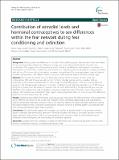| dc.contributor.author | Hwang, Moon Jung | en_US |
| dc.contributor.author | Zsido, Rachel G. | en_US |
| dc.contributor.author | Song, Huijin | en_US |
| dc.contributor.author | Pace-Schott, Edward F. | en_US |
| dc.contributor.author | Miller, Karen Klahr | en_US |
| dc.contributor.author | Lebron-Milad, Kelimer | en_US |
| dc.contributor.author | Milad, Mohammed R. | en_US |
| dc.contributor.author | Marin, Marie-France | en_US |
| dc.date.accessioned | 2015-12-04T18:13:23Z | |
| dc.date.issued | 2015 | en_US |
| dc.identifier.citation | Hwang, Moon Jung, Rachel G. Zsido, Huijin Song, Edward F. Pace-Schott, Karen Klahr Miller, Kelimer Lebron-Milad, Marie-France Marin, and Mohammed R. Milad. 2015. “Contribution of estradiol levels and hormonal contraceptives to sex differences within the fear network during fear conditioning and extinction.” BMC Psychiatry 15 (1): 295. doi:10.1186/s12888-015-0673-9. http://dx.doi.org/10.1186/s12888-015-0673-9. | en |
| dc.identifier.issn | 1471-244X | en |
| dc.identifier.uri | http://nrs.harvard.edu/urn-3:HUL.InstRepos:23845172 | |
| dc.description.abstract | Background: Findings about sex differences in the field of fear conditioning and fear extinction have been mixed. At the psychophysiological level, sex differences emerge only when taking estradiol levels of women into consideration. This suggests that this hormone may also influence sex differences with regards to activations of brain regions involved in fear conditioning and its extinction. Importantly, the neurobiological correlates associated with the use of hormonal oral contraceptives in women have not been fully contrasted against men and against naturally cycling women with different levels of estradiol. In this study, we begin to fill these scientific gaps. Methods: We recruited 37 healthy men and 48 healthy women. Of these women, 16 were using oral contraceptives (OC) and 32 were naturally cycling. For these naturally cycling women, a median split was performed on their serum estradiol levels to create a high estradiol (HE) group (n = 16) and a low estradiol (LE) group (n = 16). All participants underwent a 2-day fear conditioning and extinction paradigm in a 3 T MR scanner. Using the 4 groups (men, HE women, LE women, and OC users) and controlling for age and coil type, one-way ANCOVAs were performed to look at significant activations within the nodes of the fear circuit. Using post-hoc analyses, beta-weights were extracted in brain regions showing significant effects in order to unveil the differences based on hormonal status (men, HE, LE, OC). Results: Significant main effect of hormonal status group was found across the different phases of the experiment and in different sub-regions of the insular and cingulate cortices, amygdala, hippocampus, and hypothalamus. During conditioning, extinction and recall, most of the observed differences suggested higher activations among HE women relative to men. During the unconditioned response, however, a different pattern was observed with men showing significantly higher brain activations. Conclusions: Our data further support the important contribution of estradiol levels in the activation of brain regions underlying fear learning and extinction. The results highlight the need to document gonadal hormonal levels, menstrual cycle phase as well as oral contraceptive use in women in order to avoid overlooking sex differences when investigating the neurobiology of emotional regulation. | en |
| dc.language.iso | en_US | en |
| dc.publisher | BioMed Central | en |
| dc.relation.isversionof | doi:10.1186/s12888-015-0673-9 | en |
| dc.relation.hasversion | http://www.ncbi.nlm.nih.gov/pmc/articles/PMC4652367/pdf/ | en |
| dash.license | LAA | en_US |
| dc.subject | Gonadal hormones | en |
| dc.subject | Estrogens | en |
| dc.subject | Estradiol | en |
| dc.subject | Sex differences | en |
| dc.subject | Fear conditioning | en |
| dc.subject | Extinction memory | en |
| dc.subject | Men | en |
| dc.subject | Women | en |
| dc.subject | Conditioned response | en |
| dc.subject | Unconditioned response | en |
| dc.subject | fMRI | en |
| dc.title | Contribution of estradiol levels and hormonal contraceptives to sex differences within the fear network during fear conditioning and extinction | en |
| dc.type | Journal Article | en_US |
| dc.description.version | Version of Record | en |
| dc.relation.journal | BMC Psychiatry | en |
| dash.depositing.author | Pace-Schott, Edward F. | en_US |
| dc.date.available | 2015-12-04T18:13:23Z | |
| dc.identifier.doi | 10.1186/s12888-015-0673-9 | * |
| dash.contributor.affiliated | Marin, Marie-France | |
| dash.contributor.affiliated | Pace-Schott, Edward | |
| dash.contributor.affiliated | Miller, Karen | |
| dash.contributor.affiliated | Milad, Mohammed R. | |


